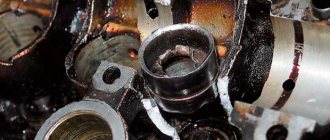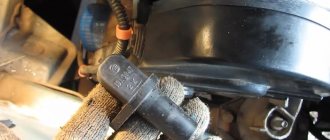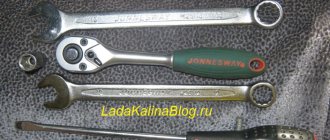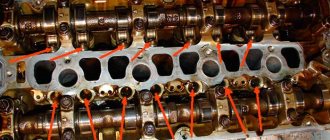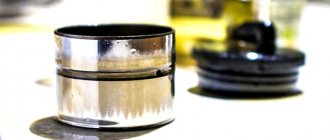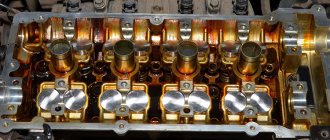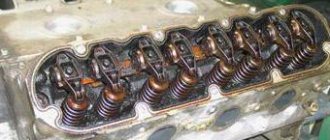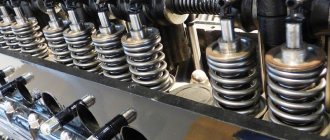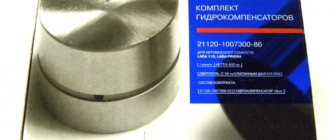Purpose and principle of operation of hydraulic compensators
Hydraulic compensators, or hydraulic compensators, are an integral part of the gas distribution mechanism (GRM) system in an internal combustion engine cylinder. When the engine warms up, timing parts heat up, which leads to an increase in their size. Therefore, thermal gaps are left between the timing parts - from 0.15 mm on the intake valves and up to 0.35 mm on the exhaust valves. One of the problems of the timing belt is mechanical wear and increase in valve clearances, as a result of which the valves do not open or close completely. The result of this is a decrease in vehicle power, difficulty starting the engine and increased exhaust toxicity. The reason for this is fuel combustion in the intake manifold or insufficient filling of the engine cylinders with the fuel mixture. Diesel cars, as a result of the incorrect size of thermal gaps, become completely inoperable.
To regulate valve clearance sizes, mechanical adjustment of levers and washers was previously used, then mechanical pushers appeared, and on modern cars they were replaced by hydraulic compensators. Hydraulic compensators automatically change their length to a size equal to the thermal gap in the timing belt.
In terms of its design, the hydraulic compensator is:
The operation of the hydraulic compensator consists of several stages.
The main advantage of hydraulic compensators is a completely automatic operating mode that does not require adjustment, since the hydraulic compensator always selects the required gap.
How did they appear?
The hydraulic compensator on VAZ cars has replaced ineffective mechanical adjustments of the timing mechanism. Often a regular valve on classic VAZ engines is not equipped with a compensator. Therefore, drivers adjusted valve clearances every 10 thousand kilometers. The work had to be done manually. The valve cover was removed, measurements were taken with a feeler gauge and the required gap was set.
If the driver did not adjust the valves, the engine operation was accompanied by loud noise, dynamics were lost, and fuel consumption increased. After about 50 thousand kilometers, the valves required replacement, as they were severely worn. As an alternative to mechanical adjustment, AvtoVAZ decided to offer a more modernized design.
On engines for front-wheel drive cars, special pushers were installed in front of the valve. A “hat” was put on the valve. The diameter of the pusher is large enough, and due to this, wear has been reduced. It takes longer for a larger diameter to wear out. Yes, the wear rate has decreased, but the need to adjust the valves remains, although now it has to be done less often.
Typically, tuning consisted of adding tuning washers, which decreased or increased the height of the pusher. This adjustment, despite its archaic nature, is quite effective, and some automakers use this method to this day. Valve clearances in such a mechanism need to be adjusted once every 50 thousand kilometers. On some foreign cars, pushers can live even longer.
Among the advantages of this solution are the simplicity of the design, the absence of oil requirements - even mineral oil will do. In addition, the design turned out to be very cheap. Among the disadvantages, reviews note that if the washer has worked, then the engine becomes noisy, fuel consumption increases, and dynamics decrease. AvtoVAZ thought about a design that would automatically regulate thermal clearances in the valve mechanism.
And so, instead of mechanical adjustments, VAZ-2112 hydraulic compensators appeared. At that time it was a completely new technology. In fact, everything is very simple - the driver no longer needs to manually adjust the gaps. The hydraulic compensators themselves will automatically select the desired parameter for each valve.
Symptoms of hydraulic lifters malfunction
The main sign of a faulty hydraulic lifters is the appearance of a mechanical knock immediately after starting the car engine. The knocks are localized at the location of the valve cover. If knocking does not appear immediately after starting the engine, but as it is running, then the cause of the knocking is not a breakdown of the hydraulic compensators.
Depending on the type of malfunction, knocking noises may be constant, or their level decreases or increases as the load on the engine changes. A knocking noise only on a cold engine is not always a consequence of a faulty hydraulic lifters; it may well be caused by low oil viscosity.
The washer nozzles are frozen: how to freeze them carefully and quickly
- the plunger pair is worn out;
- the compensator is jammed, and this happened due to oil deposits;
- the element is contaminated with scale or scale;
- the contamination came from flakes of burnt lubricant;
- there are foreign objects in the compensator or oil channel;
- There was a foreign body under the ball valve.
It is also impossible to ignore the difference in the causes of knocking on a cold and hot engine.
If you hear knocking noises when the engine is cold, but there are no knocks when the power unit is warm, there are reasons for this.
We list the main factors leading to knocking of the main engine on a cold (not warmed up) internal combustion engine:
- oil that does not meet the viscosity requirements is used;
- the pressure relief valve has failed;
- the compensator is broken or worn out;
- there is little oil in the engine;
- another liquid has entered the lubricant;
- the oil filter is clogged;
- The motorist did not change the engine lubricant in a timely manner.
Checking hydraulic compensators
In most cases, hydraulic lifters are checked acoustically - an experienced mechanic determines the malfunction even without using additional instruments. However, not every car owner will be able to identify a specific hydraulic compensator that is not working; moreover, knocking when they malfunction can be confused with improper operation of the engine valves.
An ordinary owner can be recommended to use a banal phonendoscope. With the engine running, the phonendoscope must be applied to the cylinder head at the location of each of the hydraulic compensators. By comparing the nature of the sound, you can determine a specific hydraulic compensator that is not working correctly.
Another method involves checking manually by pressing the device with a screwdriver or your fingers. During normal operation of the compensator, you need to make an effort to press. If the hydraulic compensator is easily pressed through, it will probably need to be replaced.
The latter method will require the use of a gap gauge with a diameter of 0.1 mm to 0.5 mm. If, on a hot engine, a probe with a diameter of 0.5 mm fits freely between the hydraulic compensator and the camshaft cam, then the hydraulic compensator must be replaced. The same applies to the situation when a probe with a diameter of 0.1 mm does not fit into the gap.
Repair of hydraulic compensators
In most cases, hydraulic compensators cannot be repaired, so they have to be replaced with new ones assembled. The exception is when the hydraulic compensator is contaminated with oil wear products. In such a situation, it is necessary to rinse the hydraulic compensator from carbon deposits and contamination, and then install it back. Before washing, it is necessary to remove the hydraulic compensators from the vehicle.
The hydraulic compensators can be washed with ordinary gasoline, kerosene, acetone or other suitable solution. After installing the hydraulic compensators, you should wait some time before starting the engine, as the devices need to compress. If the knocking stops, then the problem is solved.
Flushing expansion joints can extend their service life, but this does not mean that they will not have to be replaced later. To increase the service life of hydraulic compensators, it is imperative to use only high-quality synthetic oil.
Additive for Liqui Moly hydraulic compensators
One way to wash hydraulic lifters without removing them from the engine is to use the Liqui Moly additive, which is designed to clean hydraulic lifters and eliminate their knocking. It is added to the engine oil every time it is changed in the car system. The additive is used for all types of engines (gasoline and diesel) with and without turbocharging. To use the additive, you must mix 300 ml (1 bottle) of the additive with 6 liters of oil when changing it. The use of an additive on old oil is possible, but only if it has been used for no more than 5–6 thousand km. At the same time, the effectiveness of using the additive on old oil decreases.
The additive helps to avoid knocking of hydraulic compensators by cleaning the valve holes and oil channels of hydraulic compensators. A positive side effect of using the additive is improving the lubricating properties of the oil.
It should be understood that the use of auto chemicals will not help in any way if the causes of knocking hydraulic compensators are associated with mechanical wear of parts. You should not expect that the additive will become a panacea for all “diseases” of a car engine. Worn hydraulic compensators or an oil pump cannot be “treated” by injecting an additive.
Lada 2112 ᵀᴴᴱ ᴼᴿᴵᴳᴵᴺᴬᴸ › Logbook › Replacing hydraulic compensators on VAZ-2110, 2111, 2112
Hydraulic compensators (hydraulic pushers) of valves are used to automatically adjust thermal valve clearances. In essence, they are a kind of gaskets between the camshaft cams and valves, capable of changing their thickness.
Their use in the engine makes it possible not to systematically adjust thermal clearances.
The design of the hydraulic compensator consists of a cylinder-shaped body and a plunger, including a bushing, a ball valve and a spring.
The principle of its operation is as follows.
When the cam turns its blunt side towards the pusher, a gap appears between them. At this time, the spring-loaded plunger rises up, closing it, and the oil enters the plunger cavity through a channel with a ball valve. Turning the other side, the cam presses on the pusher, directing it down. The valve is closed by a ball. In this way, the plunger transmits the force of the cam directly to the valve. Malfunctions of hydraulic compensators The main indicator of failure of hydraulic compensators is their characteristic knocking sound.
It is he who signals that it is time for a replacement. There may be several reasons for this: spent resource;
premature wear of the plunger pair due to wear products entering the device; clogged oil supply channels. If the hydraulic pushers have become unusable after working for the required period, it means that the car owner paid maximum attention to the engine.
But the other two cases are a consequence of the use of low-quality, inappropriate oil, its untimely replacement, malfunctions of the oil pump or other elements of the lubrication system.
The hydraulic compensator will work ideally only when its internal space is completely filled with oil.
Otherwise, dynamic loads will gradually destroy it and they begin to knock. Replacing hydraulic compensators with your own hands The process of replacing hydraulic compensators is not difficult in itself, but you will have to work hard to implement it, because it involves dismantling the valve cover and camshafts.
The order of work is as follows. 1. Place the car on a flat surface and secure it with the parking brake.
2. Raise the hood of the car, disconnect the negative terminal.
3.Remove the engine protective cover. 4. Dismantle the receiver. We plug the inlet holes with a clean rag to prevent foreign objects and dirt from getting inside. 5. Dismantle the ignition module and crankcase ventilation hose. 6. Unscrew the bolt fixing the bracket for the injector power wires.
7. Unscrew the 15 bolts securing the cylinder head valve cover and dismantle it.
8.Having removed the cover, we check the condition of the hydraulic compensators by pressing on them from above with a screwdriver. A working hydraulic pusher should compress with great force. If significant effort is not required to compress it, the compensator is faulty. 9.Remove the drive gears from both camshafts. 10. Disconnect the oil pressure sensor connector.
11. Unscrew the 20 bolts securing the bearing housing.
12.Unscrew the nuts securing the rear shaft support bracket. 13. We dismantle it together with the bearing housing along with the spark plug guides. 14. We take out both camshafts (we put them back according to the marks) 15. To remove the hydraulic compensators from their sockets, we use a magnet. 16. We remove the old hydraulic pushers.
We install new ones in their place. 17. Installation is carried out in the reverse order, do not forget to set the camshaft marks.
18. We get rid of sealant residues at the joints with the cylinder head. We take into account the tension of the head mounting bolts. 19. Before assembly, apply special Loctite sealant to all head joints. Result of the work Having completed the installation work, we check the operation of the engine.
Immediately after starting, the engine may work, making extraneous sounds in the form of clattering or tapping. They indicate that the hydraulic compensators need to be pumped, i.e. fill with oil, expelling the air. To carry out this procedure, start the engine and run it for 5 minutes at 2500 rpm. After this, go to idle speed and wait 30 seconds. Next, turn off the engine and wait a minute.
Next time you start, listen again. If the sound does not disappear, repeat the procedure. Usually after 3-5 such pumpings the extraneous sounds disappear.
Source
About the design of gas distribution mechanisms
How to check spark plugs yourself
In a simple case, the compensator is an extension of the valve heel. More precisely, the hydraulic compensator is mounted on the valve and transmits the force received from the cam. This diagram is clearly shown in the figure:
Here the compensator comes into contact with the cam
What is considered is one of the options. But there is another one, when the cam presses on the rocker arm. The rocker itself is pushed up by two different elements. On one side it will be a valve, on the other - a hydraulic compensator. The first of them moves, the second remains at the same level:
The compensator presses on the rocker from below
If the compensator is faulty, a gap will appear between the cam and the rocker arm.
Previously, the timing design used a single camshaft (SOHC), and the force to the valve heels was transmitted through a lever. In order to eliminate the gap, the lever was equipped with an adjusting screw 5. It was fixed with a lock nut 6:
Timing diagram with lever rocker arms
The mechanism discussed above can be equipped with hydraulic compensators. Their device is shown in Figure “b”:
Schemes “a” and “c” correspond to the first and second cases. There shouldn't be any questions here.
Note that hydraulic compensators are not used in the design of the 4A-FE and 5A-FE (Toyota) engines. They are available in motors of the following series: 2S, 1NR, ZR, TR, 5M.
SKYLINE636 › Blog › useful information about hydraulic compensators
The hydraulic compensator, also known as a hydraulic pusher, is designed to automatically adjust the thermal clearances of engine valves. While operating the car, you can hear the engine knocking, they say it is the hydraulic compensators knocking. Do you know the causes of this malfunction and how to deal with it?
For hydraulic compensators to operate, a constant supply of oil under pressure is required. To do this, there is a channel in the cylinder head with a check ball valve (it prevents oil from draining from the channels after stopping the engine), as well as channels on the lower plane of the bearing housing (they also supply oil to the camshaft journals).
Hydraulic compensators are very sensitive to the quality of the oil and its purity. If there are mechanical impurities in the oil, rapid failure of the hydraulic compensator plunger pair is possible, which is accompanied by increased noise in the gas distribution mechanism and intense wear of the camshaft cams. A faulty hydraulic compensator cannot be repaired and must be replaced. If after replacement the new hydraulic compensators knock, this is normal, but only for a short time. If the knocking does not stop, the cause should be determined.
How to determine which hydraulic compensator is knocking?
To check the hydraulic compensator, you need to press it with a soft metal drift or a screwdriver (with the camshaft cam facing the pusher with the back of its head). In normal condition, the hydraulic pusher should be pressed with considerable force. If the force is small, the hydraulic pusher must be replaced. Install the camshaft cams one at a time with the protrusions facing up and check for clearance between the pushers and the cams. When pressing (for example, with a wooden wedge) the hydraulic pusher being tested, compare the speed of its movement with the others. If there is a gap or an increased speed of movement, disassemble the hydraulic compensator and clean its parts from dirt or replace the hydraulic compensator.
●If the hydraulic compensators knock when starting:
The cause of the malfunction is oil leakage from part of the hydraulic compensators during long-term parking. Remedy - noise that disappears a few seconds after starting the engine is not a sign of a malfunction, since some of the hydraulic compensators that were under the load of the valve springs of the open valves (the oil supply channels remained open) leaked oil, the deficiency of which is replenished at the beginning of engine operation.
●Hydraulic compensators knock when cold and hot, the noise disappears when the speed increases:
The cause of the malfunction is damage or wear of the check valve ball. Contamination of the hydraulic compensator mechanism with wear products due to untimely oil changes or poor quality.
Remedy: Replace the hydraulic compensator. Clean the mechanism parts from dirt. Use the oil recommended in the owner's manual.
●Hydraulic lifters knock when hot, the knock disappears after increasing the speed. There are no problems when the engine is cool:
The cause of the malfunction is the flow of oil through the gaps between the plunger and the hydraulic compensator sleeve, which have increased due to wear. Remedy: Replace the worn hydraulic compensator assembly.
●Hydraulic compensators knock at high speeds, but there is no knock at low speeds:
The cause of the malfunction is foaming when there is excess oil (above the top mark on the dipstick) in the oil sump due to its agitation by the crankshaft. If an air-foamy oil mixture gets into the hydraulic compensators, it disrupts their operation. Air being sucked in by the oil pump when the oil level in the oil sump is too low. Damage to the oil receiver due to deformation of the oil sump when hitting a road obstacle.
●Continuous noise of one or more valves, independent of crankshaft speed:
The cause of the malfunction is the occurrence of a gap between the pusher and the camshaft cam due to damage or contamination of the hydraulic compensator parts.
Remove the cylinder head cover, install the camshaft cams one at a time with the protrusions facing up and check for clearance between the tappets and the cams. When pressing (for example, with a wooden wedge) the hydraulic pusher being tested, compare the speed of its movement with the others. If there is a gap or an increased speed of movement, disassemble the hydraulic compensator and clean its parts from dirt or replace the hydraulic compensator.
Most often, hydraulic compensators knock due to insufficient oil level or poor quality. Don’t rush to disassemble the engine and look for the cause; try simply replacing the oil with the one recommended by the manufacturer. Another question that worries many is “is it possible to drive if the hydraulic compensators are knocking?” Answer: you can.
Source
Reviews
| № | Positive |
| 1. | Vasily: I drove a little more than 50,000 km, there is no knock in the gas distribution mechanism. I regularly fill up with high-octane fuel and fill in Shell 10W-40 semi-synthetic oil. |
| 2. | Konstantin: in two years of active operation of the machine, the valve knocked once. As the service station worker found out, the reason was that the fastening nut was not tightened sufficiently. Half an hour later I was driving the car again. |
| 3. | Vladlen: I recently noticed dark-colored exhaust gases coming from a car, I thought there was a problem with the gas distribution mechanism. During the diagnostics, it turned out that there was a violation in the enrichment of the mixture in the system, as a result of which carbon deposits formed. |
| 4. | Ignat: I heard a lot of complaints about the gas distribution mechanism, I didn’t have any breakdowns in a year and a half of using the car. Perhaps the reason is constant maintenance, careful handling, refueling with high-quality oils and fuel. |
| 5. | Ivan: in two years of using the car, I cleaned the gas distribution mechanism once for preventive purposes. The machine works stably, there are no complaints. |
| Negative | |
| 1. | Vitaly: after 55,000 km, the valves began to knock, I took the car to the service center, and it turned out that the leg was deformed. Replaced with new ones, they gave a guarantee. Dissatisfied with the quality of workmanship. |
| 2. | Kirill: at the first convenient opportunity, re-tighten the valve mechanism on the Lada Granta. Lots of defects, poor quality fitting, loose knots. |
| 3. | Slavik: in the third year of operation of the machine, I replaced the valve mechanism with a new one. The old one has fallen into disrepair. |
Conclusion
The average service life of the gas distribution mechanism of the Lada Granta does not exceed 50 - 60 thousand km. In order not to reduce the resource, periodically carry out preventative maintenance on your car, replace worn parts with new ones.
Refilling with high-quality motor oils and high-octane fuel will only increase the life of the valve mechanism.
Often, the cause of premature wear of timing elements is an aggressive driving style. Increased load and high temperatures contribute to premature wear of components.
Hydraulic compensators and malfunctions in them
Let's immediately determine that the knocking of the hydraulic compensator is a problem that occurs in 90% of cases not on new cars, although exceptions are possible if a low-quality part was installed at the factory. But this is also unlikely, since the hydraulic compensator belongs to the power unit, and factories producing engines have much more stringent requirements regarding the quality of components supplied by suppliers.
Problems with knocking hydraulic compensators can arise over time on a car of any make, year and country of manufacture.
There are a number of ways to eliminate annoying sound, each of which should be used in a specific situation.
But in order to understand why the hydraulic compensator is knocking and the reason for its failure, you first need to understand what kind of mechanism it is, what it consists of, and how it functions. And in general, what can such a knock lead to, and what will happen if it is not eliminated in a timely manner.
Hydraulic compensator for a car - simple about complex things!
In order to understand the principle of operation of the hydraulic compensator, and therefore determine why it fails and how to repair it, you need to remember the design of the engine. Do you remember how the valves are located and what they are for? The intake valve is responsible for the supply of fuel, and the exhaust valve is responsible for the exit of gases exhausted during fuel combustion in the engine.
So, a hydraulic compensator is a device that regulates the valve clearance automatically, thus ensuring a uniform supply of fuel to the working chamber of the engine and the exhaust outlet. Installing hydraulic compensators eliminates the process of manually adjusting the valves for the manufacturer's servicemen, which, by the way, is very labor-intensive and time-consuming.
Self-adjustment method for valves
- In the engine compartment we remove attachments, decorative plates, and air ducts.
- Unscrew the valve cover.
- Jack up one side of the wheel and turn it until the shaft elbow is in the uppermost part.
- Use a metal feeler gauge to measure the valve clearance. Tighten and loosen the control nut as necessary.
By analogy, we complete the work in the remaining cylinders.
Why do hydraulic compensators knock?
Now let's move on to closely examining the question of where that unpleasant knocking noise from under the hood of your car comes from.
There are usually two common reasons:
1. The knocking noise occurs due to damage or destruction of the mechanical parts of the hydraulic compensator itself. 2. Knocking occurs due to a malfunction of the systems supplying oil to the engine.
Professionals even know how to identify a knocking hydraulic compensator by ear, and what exactly the problem is.
The reasons for the destruction of the mechanisms of the hydraulic compensator itself include the depletion of the service life of the plunger pair installed inside the hydraulic compensator. This happens over time, unfortunately, the process is inevitable, so replacing hydraulic compensators should be treated like replacing any automotive “consumables”. Depending on the quality of the components used in the production of the hydraulic compensator, its service life directly depends. The lower the quality of the metal, the faster it will fail. Naturally, there may also be a manufacturing defect. Also, the hydraulic compensator is damaged if air gets into it, or too little oil, or due to contamination of the hydraulic compensator parts. There are many reasons, but the result does not change - the mechanism fails and requires either cleaning, if you diagnosed the problem at an early stage, or complete replacement, if at a later stage.
Regarding problems with oil supply to the engine. A knock will occur if the oil level in the engine differs from the norm, both down and up. End of service life and failure of the oil filter. Contamination or ingress of carbon deposits into the oil channels that form during engine operation.
Choosing the wrong brand of oil. Naturally, if you overheat the engine, the physical properties of the oil will change, which will also lead to disruption of the oil supply systems.
We have already said above that knocking can occur both when the engine is cold and when the engine is warm.
On a hot engine, the presence of knocking is most likely due to the presence of oil in the engine, which is high time to change, or if you have recently done this, it means that you have come across oil of poor quality - this, by the way, is another reason to buy lubricants only from official representative offices or dealers. Filling with low-quality oil can cause engine damage much more serious than knocking hydraulic lifters.
It often happens that replacing the oil with a new one solves the problem with knocking hydraulic compensators.
If you have not changed the oil filter for a long time, then be sure to replace it, or at least clean it, for which you should use a special hydraulic compensator cleaner.
Although, according to the vehicle maintenance regulations, the oil filter is supposed to be changed simultaneously with the oil change.
If all of the above operations do not produce any results, you should consider other options for the occurrence of knocking in the engine compartment, since replacing the filter and using high-quality engine lubrication in 90% of cases helps solve the problem. Remember that a knock under the hood when the engine is warm is a critical indicator and requires urgent intervention and elimination of the cause of its occurrence.
And vice versa, if your hydraulic lifters are knocking on a car that is not yet warmed up, it is not of fundamental importance. Cold oil has different physical characteristics from hot oil and does not get inside the hydraulic compensator, so you just need to wait until the engine warms up. If the knocking persists, then you should begin to solve the problem.
Lada Granta problems that all owners face
Lada Granta went on sale at the end of 2011.
And it was created on the basis of the Lada Kalina, which, in turn, inherited many of the technical solutions of the VAZ-2108 Sputnik, first shown at the Autoprom 1984 exhibition. Typically, manufacturers update the model every 5–6 years. And Granta will soon celebrate its tenth anniversary, so it can be considered obsolete even in terms of its assembly line life. When developing Grants, they used the in-plant designation of the project “Low cost” (low cost). And now the car, despite the fact that the price has more than doubled compared to the initial price of the basic configuration (229,000 rubles), remains one of the most affordable cars on our market. Many of the problems that owners encounter during operation stem from “budgeting.”
Engine
The design of the engine, which is based on a cast iron cylinder block, is quite reliable. Recently, all the engines that are installed on Grants have become non-plug-in, that is, if the timing belt breaks, the pistons do not meet the valves. This allows owners to save a tidy sum that they could otherwise spend on repairs. But it does not eliminate the main problem - low-quality components. Our editorial team has undergone long-term testing of three cars: Lada Granta, Kalina and the platform-compatible Datsun mi-DO. In each car, the timing belt broke before it reached the deadline for its replacement according to the regulations.
Problematic parts also include the thermostat and ignition coils. The latter sometimes have to be changed several times with a mileage of up to 100,000 km. Other malfunctions characteristic of Grant engines, although they occur quite often, do not have any serious consequences: unstable engine operation (speeds fluctuate) at idle, increased (in some copies) vibration during operation.
Transmission
The manual transmission has been modernized more than once. It now has a cable drive, thanks to which the gears are engaged with less effort, and the accuracy of the selection mechanism has increased. This box has the factory index VAZ-2181. But the sound when its gears operate is still too loud. The problem with the second gear synchronizer has not been completely resolved. Poor engagement and rapid wear of the synchronizer, despite numerous upgrades, still occur. As well as oil leaks through the seals. The reason is the low quality of the seals themselves and the insufficient accuracy of the positioning of the seal relative to the shaft. All this fully applies to the VAZ-2182 robotic gearbox, because it was created on the basis of a mechanical one.
In the case of gearbox 2181, the clutch mechanism rarely lasts more than 100,000 km, especially if the car is used in a big city and often sits idle in traffic jams. In robotic gearboxes, the clutch lives even less.
The only truly reliable transmission in the line is a 4-speed automatic from the Japanese company Jatco.
Chassis
Owners who have had the opportunity to travel not only behind the wheel of products of the domestic automobile industry, note that the Granta’s handling is far from ideal: the car does not hold a straight line well, behaves unstably when cornering and when braking. The main reason is the lack of a subframe.
As for the reliability and service life of suspension elements, shock absorber struts sometimes start knocking before the first maintenance. With a mileage of 80,000 km, the front fastenings of the front suspension arm braces may crack and fail. Ball joints rarely run more than 60,000 km. The remaining parts of the front suspension have an acceptable service life.
The rear suspension design is simple and reliable. Except that the service life of the wheel bearings is short - sometimes they have to be replaced at 40,000 km. The steering rack often begins to tap at 50,000 km. Adjusting the rack and pinion mechanism does not always help. The resource of the front brake mechanisms is also insufficient. It has been noted that the pads wear out quickly, and the discs are not durable. Sometimes discs, having survived three sets of pads, ask for replacement at 75,000 km. The rear brake mechanisms have their own problems: the handbrake cables become sour, the brake cylinders leak. And all this, as a rule, with mileages up to 100,000 km.
Electrics and body
The generator bearings have insufficient life. They can begin to hum by 80,000 km. Power windows often squeak and raise the windows slowly due to glass jamming in the seals. Electric window motors often fail. You can also note the leakage of the rear lights of sedans: not only water, but also insects penetrate inside.
The paint on the body can be easily damaged by stones flying from under the wheels of other cars. The resulting paint chips “bloom” quite quickly. The paint layer is so thin that it is sometimes rubbed off by the door seals. The seat adjustment knob often breaks off.
All of the listed problems with Grants are a consequence of either an outdated design or a budgetary approach to production. It is obvious that Grant has exhausted its possibilities for modernization. We need a new platform and a new level of security. Lada Granta is the last car in production today that does not have a front subframe - an important element that serves to reduce noise and vibration, as well as increase the passive safety of the car.
It’s always worth telling how your Granta never broke down (or broke down every thousand kilometers) in the comments below.
- What the new Grant will be like, read here.
Which hydraulic compensator is making the knocking noise?
To determine which hydraulic compensator is making a knock (usually their number is equal to the number of valves in your engine), they use a diagnostic method “by ear”, using a technological version of such a medical device as a phonendoscope - you have almost certainly seen it on your therapist’s neck.
It is this device that allows the master to say exactly where the source of the knocking lies, although real professionals, of course, will determine this without any phonendoscope.
After diagnosing the knocking part, you need to remove the hydraulic compensator, thoroughly clean it, then install it in place and start the engine again.
If the knocking noise persists, the hydraulic compensator is considered to be out of order, and the service will replace it.
If the knocking continues after replacement, the reason most likely lies in the quality of the oil used, or in other engine components. The latter is unlikely, since diagnosing a sound source using a phonendoscope is an accurate procedure and, as a rule, does not cause failures.
